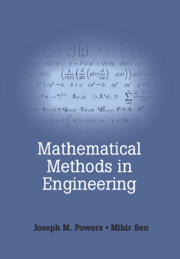Book contents
- Frontmatter
- Dedication
- Contents
- Preface
- 1 Multivariable Calculus
- 2 Vectors and Tensors in Cartesian Coordinates
- 3 First-Order Ordinary Differential Equations
- 4 Linear Ordinary Differential Equations
- 5 Approximation Methods
- 6 Linear Analysis
- 7 Linear Algebra
- 8 Linear Integral Equations
- 9 Dynamical Systems
- Appendix A
- References
- Index
6 - Linear Analysis
Published online by Cambridge University Press: 05 February 2015
- Frontmatter
- Dedication
- Contents
- Preface
- 1 Multivariable Calculus
- 2 Vectors and Tensors in Cartesian Coordinates
- 3 First-Order Ordinary Differential Equations
- 4 Linear Ordinary Differential Equations
- 5 Approximation Methods
- 6 Linear Analysis
- 7 Linear Algebra
- 8 Linear Integral Equations
- 9 Dynamical Systems
- Appendix A
- References
- Index
Summary
This chapter introduces some more formal notions of what is known as linear analysis. It is in fact an abstraction of not only much of the analysis of previous chapters but also of Euclidean and non-Euclidean geometry. Importantly, we define in a more general sense the notion of a vector. In addition to traditional vectors that exist within a space of finite dimension, we see how what is known as function space can be thought of as vector space of infinite dimension. Additionally, we generalize the concepts of (1) projection of vectors onto spaces of lower dimension, (2) eigenvalues and eigenvectors, and (3) linear operators. Two important engineering analysis tools are discussed: the method of weighted residuals and uncertainty quantification via polynomial chaos. Others exist or could be easily inferred in any engineering system modeled by linear equations. Throughout the chapter, we introduce and use some of the more formal notation of modern mathematics, which, for many students, will be the key to enabling further studies in more mathematical realms.
For this and the next two chapters, we largely confine our discussion to linear systems. However, the ideas developed are of critical importance when we return to nonlinear systems in Chapter 9, which, once again, relies on local linearization to illuminate globally nonlinear behavior.
Sets
Consider two sets A and B. We use the following notation:
x ∈ A, x is an element of A,
x ∉ A, x is not an element of A,
A = B, A and B have the same elements,
A ⊂ B, the elements of A also belong to B,
A ∪ B, set of elements that belong to A or B, that is, the union of A and B,
A ∩ B, set of elements that belong to A and B, that is, the intersection of A and B,
A − B, set of elements that belong to A but not to B.
Information
- Type
- Chapter
- Information
- Mathematical Methods in Engineering , pp. 279 - 389Publisher: Cambridge University PressPrint publication year: 2015
